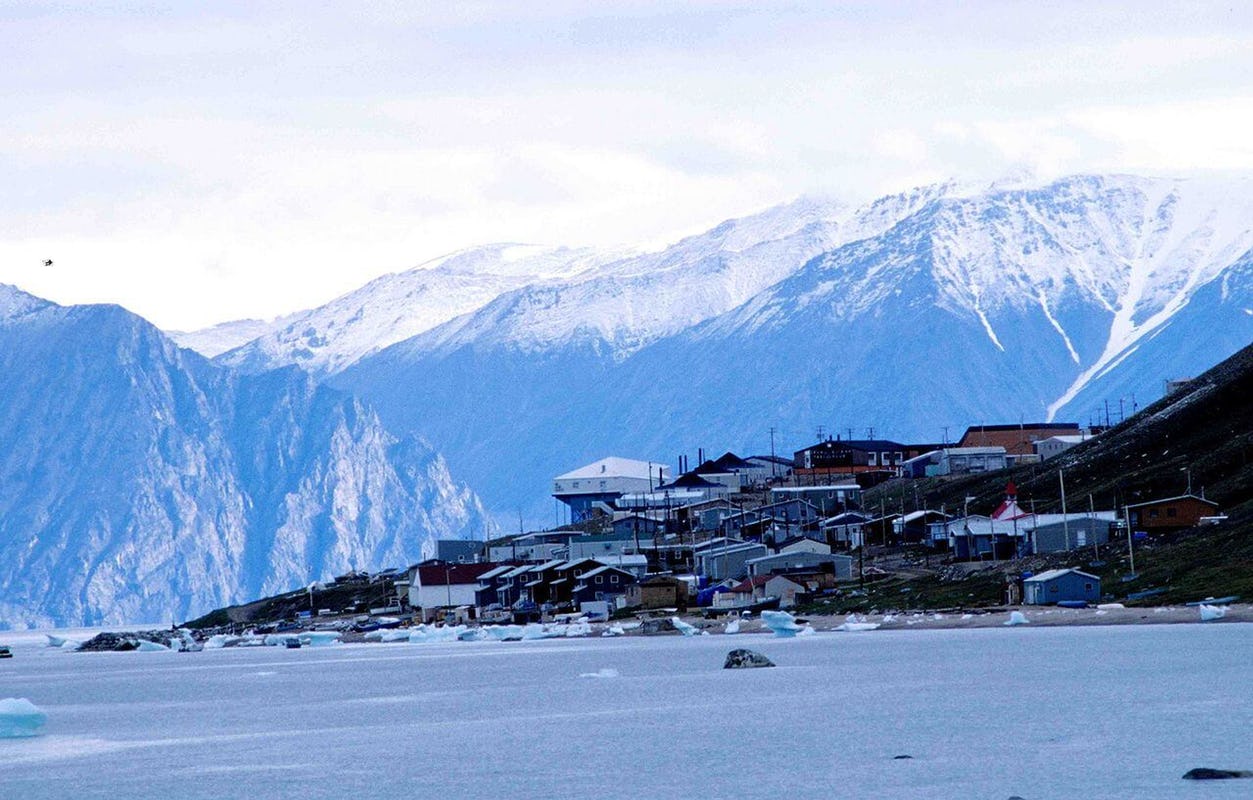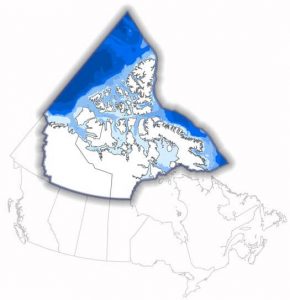Canada and the Arctic: An Ambiguous Relationship

Pond Inlet, Nunavut, is located between the fjords and the Arctic Ocean. Photo: Ansgar Walk
Canada undoubtedly holds a prominent place in the Arctic. Currently in the Arctic, only Russia has more Arctic territory, making Canada an “Arctic superpower” in terms of geography and location. As foreign minister Baird announced on December 9, its recent claim for an extension of its continental shelf claim stretched as far as the North Pole.
Canadian nation-building has at times also been concentrated around its “true north”.1) Yet, 75 percent of the Canadian population is based within 100 miles from the United States border, more than 1.000 miles beneath the Arctic Circle.2) Its Arctic population, residing in the three territories Yukon, Northwest Territories and Nunavut, only numbers approximately 100.000 inhabitants, which is less than 0.3 percent of Canada’s total population.
Arctic policies are, for all Arctic states, a mix of domestic and foreign policy. Similarly, in its policy for the Arctic, the Canadian federal government in Ottawa needs to balance the interests of the residents actually residing in its Arctic territories and the foreign policy interests of Canada at large. These different set of interests do not always converge, as this article will attempt to highlight. As a consequence, Canada’s actual Arctic policy can be termed somewhat “bi-polar”, juggling different sets of domestic interest while attempting to formulate a coherent foreign policy approach towards its Arctic neighbors. This juggling is a common trait amongst all the Arctic states, yet the Canadian case is especially pronounced in nature.
Comparing the Arctic Five
All Arctic coastal states are interesting case studies for center-periphery conflicts and the complicate intricacies of formulating foreign policy in tandem with rapid domestic regional development. Alaska holds a special role in the United States, far removed from the lower 48 in both geography and mentality, while forming a cohesive entity pushing for increased federal engagement in everything from resource development to the formulation of a coherent US Arctic policy.3) In Greenland, consecutive self-governments have put economic independence from Denmark on top of the political agenda, with the idea of full-fledged independence looming in the background, as increased autonomy was granted in 2009.4)
Frontier Lands Courtesy of Government of Canada

On the other side of the Pole, Norway’s Arctic counties (Nordland, Troms and Finnmark) hold 10 percent of Norway’s total population and are, as a consequence, relatively well integrated into the national economy as a whole. There is no marked difference between the Norwegian Arctic and the rest of Norway. Svalbard, being governed by the 1920 Treaty, is a special case with a population of only 2.195.5) Russia is in a strong position, with half of the total Arctic territory and a majority of the Arctic population. Just Murmansk oblast has a population of approximately 787.000, which is almost eight times the Canadian Arctic or almost the double of the Norwegian Arctic.6) At large, the Arctic has a prominent role in Russian contemporary strategic thinking, while also constituting the backbone of its natural resource extraction.
Canada: Domestic Policy
Returning to Canada, its three Arctic territories are in a unique situation in terms of regional autonomy. Whereas the ten provinces south of the Arctic Circle have a high degree of autonomy ever since the Dominion was formed in 1867 because of their recognized constitutional powers in section 92 of the Constitution Act (formerly the British North American Act), the three northern territories have not enjoyed the same privileges and operate “at the pleasure of the Crown”. The regional governments of Northwest Territories, Yukon and Nunavut have a substantially lower degree of autonomy than their southern neighbors, but also compared to that of their American and Greenlandic counterparts.Nunavut in particular did not become a territory of its own until 1999, decades after claiming its Inuit heritage as separate from the Northwest Territories. Although the federal government in Ottawa is slowly devolving decision-making competence and authority to the territories, the starting point is relatively low, as most decisions are still made by the federal Department for Aboriginal Affairs and Northern Development (AANDC).7) It is also the only one of the three territories to not have devolved powers over natural resources.
Turning towards infrastructure and local capacity, the situation is very different in the Canadian Arctic than in the provinces. Every year since 2005 Stephen Harper has travelled to the northern territories and has thus displayed continued Arctic commitment by Ottawa, with promises of investment. As argued by Whitney Lackenbauer, focus in recent years has been on enabling natural resource development in the region, while serious deficiencies in social conditions and at the community level are being neglected.
In terms of infrastructure, there are also no deep water ports in any of the three territories, while the closest search and rescue centers are in Halifax, Nova Scotia, and Trenton, Ontario, well beneath the Arctic Circle.8) An offshore presence from the Canadian Coast Guard (CCG), in terms of icebreaking capability, is only active in the summer months during the sealift season, when the small communities in Nunavut are being re-supplied. Should a serious incident, in terms of an oil spill or a grounding of a cruise ship, the lack of capacity combined with limited infrastructure might prove catastrophic.
Canada: Foreign Policy
Moving to the foreign policy dimension of Canada’s Arctic engagement, sovereignty has continuously been on the agenda. The current Conservative Prime Minister, Stephen Harper, has placed security issues high on the agenda with quotes like “use it or lose it” and promises of investment in a deep-water docking facility, Arctic capable patrol ships and a new Arctic training centre.9) The recent claim to the North Pole has similarly been mentioned as a potential source of conflict.10)
The actual threats to Canadian sovereignty, however, are few and far between. Canada’s territorial disputes in the Beaufort Sea with the United States, and over Hans Island with Denmark/Greenland, are minor, with limited potential of ever becoming more than diplomatic disagreements. The disagreement with the US over the status of the Northwest Passage, as internal waters or an international transit, is also an issue where the two have agreed to disagree, which does not prompt increased military presence in the area. Its recent submission to the UN Commission determining the limits of the continental shelf, is another area where all the Arctic littoral states have agreed to abide to the UNCLOS framework, reiterated continuously since the Ilulissat Deceleration in 2008.
Still, protecting Canadian sovereignty in the north seems a particular foreign policy goal. The results, however, are pending also in this area. Promises of military investments have not been followed through, as exemplified with the Arctic patrol ships. The first ship was initially set to be delivered in 2014, while recent budget leaks now show that construction is set to first begin in 2015.11) As a result, the foreign policy rhetoric does not match domestic action. It is consequently not Canadian sovereignty that is under threat in the Arctic, but rather its domestic ability to provide basic public capacities.
Conclusion – Merging Domestic and Foreign Policies
Canada’s Arctic development seems somewhat twofold. On the one hand, Canada actively participates on the international stage in Arctic matters, emphasizing its sovereignty, rights and seabed claims, in addition to its Arctic Council slogan “Development for the people in the North”. On the other hand, domestic development and actual investments are lagging behind its Arctic neighbors, with serious gaps in infrastructure and local/regional capacity. The Canadian Arctic territories are also granted less autonomy and self-governance than the rest of the country’s sub-national units, with a slow process of devolution, in particular with regards to Nunavut.
When comparing Canada to the other Arctic coastal states, the gap between rhetoric and factual development becomes apparent. Amongst the Nordic countries, the Arctic regions are relatively well enmeshed in nation building at large, while Russia has placed a considerable emphasis on its Arctic region, both rhetorically and in terms of investments. The Greenlandic self-government is in the driving seat of its own development, while Alaska has a particular strong Arctic voice, encouraging Washington to look northwards. Yet, the federal government in Ottawa understands that it needs to engage its Arctic territories, as can be seen by the inclusion of regional representatives in its delegation to the Arctic Council. Inclusion and dialogue, however, is one thing. Actual investments and capacity building is something else, no matter who owns the North Pole.
References